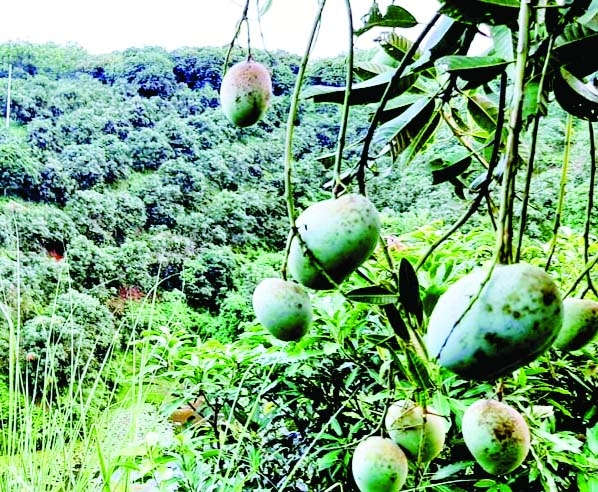
Our Correspondent :
A revolution has taken place silently in the hill districts of Bangladesh. There is now a green mango orchard on a hill covered with forest. When you see mangoes hanging in bunches, you will be overwhelmed. Even two decades ago, it was not possible to eat mountain mangoes. Hundreds of mangoes would grow on the trees and no one would be able to eat them. Because of the lack of pesticides and lack of proper care, they would catch insects. But now that situation has changed. Mango revolution has taken place in the mountains as well as in the plains. Every year the land for mango cultivation in the hills is increasing. Mango is showing the way for additional income of hill farmers.
Farmers in the hill districts have started a mango revolution. The people of the hills used to meet the demand of Amai who once came from the plain district. Now this hilly area like Rajshahi or Chapainawabganj has also become famous for mango. Farmers have opened the door to the possibility of producing improved varieties of mangoes in the hills by cultivating commercially planned mangoes. Not only with the help of the government, the farmers have brought enviable success in cultivating improved varieties of mangoes in the barren hills of the hills with their hard work and efforts.
Once a zoom land or dense jungle so now it has turned into a mango orchard. Mangoes of different varieties including amrapali are hanging in bunches on the trees. The look of the mountain has changed. Rows of mango trees are now attracting the attention of all the small and big mango orchards in the three hill districts of Khagrachhari, Rangamati and Bandarban. The most expensive mangoes in the world, including Miyazaki in Japan, are also being cultivated on the slopes of the hills. However, most of the hills in the Chittagong Hill Tracts are occupied by Indian Amrapali mangoes.
Bandarban has the largest number of mango orchards among the three hill districts. Most of the orchards of large commercial agro farms are located in the district. Our hill districts are not far behind Rajshahi district which is known as mango district in the country. Agriculture experts say that the hill districts will soon move closer to the Rajshahi division in mango production. According to the Department of Agriculture, the target for mango production in Rajshahi district this year has been set at 215,100 metric tonnes from 16,000 hectares of land. On the other hand, mango cultivation has been done in 13 thousand 342 hectares of hilly hills in three hill districts this year. Mango production target is 1 lakh 51 thousand metric tons. Of this, about 35,000 metric tons in 3,379 hectares of land in Khagrachhari, 26,312 metric tons in 2,392 hectares in Rangamati and about 90,000 metric tons in 8,561 hectares in Bandarban.
Amrapali mango cultivation started in the hills in 1998-99 under the Kalikapur Model Project. At the initiative of Chittagong Hill Tracts Development Board, the farmers were encouraged to cultivate mango with free saplings, fertilizers etc. The garden gradually expanded as it yielded less, produced more, tasted better and was in high demand in the market. At one time thousands of acres of mango orchards were established here on the initiative of individuals. Additional Deputy Director of the Department of Agricultural Extension in Chittagong. Nasir Uddin Chowdhury said that the people of the hills have resorted to mango cultivation as it has better yield and is more profitable.
Guimara Upazila Hafchhari Union successful mango farmers Ali said he was once a day laborer. He planted mango orchards on his own hilly land in 2001 with the help of Chittagong Hill Tracts Development Board and is now financially well off. Last year, he earned about Tk 6 lakh by selling mangoes. He said the profit will be much higher this year as the yield is very good. Md. Through Ali cultivation like Ali, the economic condition of the poor people in the hilly areas including small ethnic groups has changed a lot.
Compared to Rangamati and Bandarban, the yield in Khagrachari has been much better this time. Mangoes are being supplied to various plain districts including Chittagong and Dhaka across the hilly areas. Mango fruits of all varieties including Amrapali, Mallika, Rangui, Bari-4 have been good this year. Visiting various mango orchards, it is seen that the farmeTk. are picking mangoes from the trees with their wives, sons and daughteTk. . Each Amrapali tree holds an average of 50 kg of mango. Amrapali harvesting started from the first week of this month. In Khagrachari, good quality amrapali is being retailed at Tk. 55-60 per kg and wholesale at Tk. 45-50 per kg. Wholesale traders of Dhaka, Chittagong, Feni and Comilla bought the lion’s share of mangoes. Mango Bikini is also running online this year. Farmers do not apply formalin or any toxic pesticides in the garden. As it is free from toxins, the demand for mangoes in the orchards here is also high.
Bangladesh Agricultural Research Institute Chief Scientific Officer Muhammad Zulfiqar Ali Firoz said that the soil and climate of the hilly areas are very suitable for the cultivation of different varieties of mango. He said it was important to set up a mango processing plant and build a cold storage facility to make more use of the mangoes produced in the hills. In this way the farmers will get fair price of fruits and huge amount of fruits will be saved from rotting.

